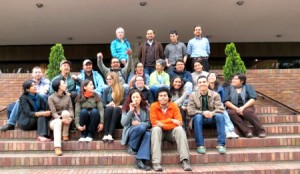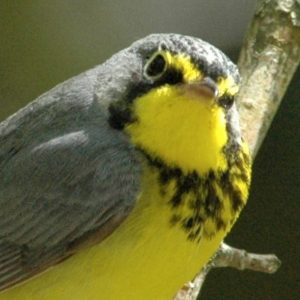The Canada Warbler

Ted Cheskey, Senior Conservation Manager
[separator headline=”h3″ title=”Coming together for its recovery”]
People who care about the Canada Warbler are coming together to help plan its recovery. On March 10, Nature Canada is hosting 30 scientists, conservationists and resource managers in Ottawa to apply the best, most-recent science and problem-solving to halt the decline of this diminutive and federally threatened species.
Environment Canada, which is responsible for implementing Canada’s Species at Risk Act, BirdLife International, Swarovski Optik, Weyerhaeuser, and the Sustainable Forestry Initiative (SFI) are supporting this important workshop.
The SFI Forest Management Standard mandates responsible forestry practices that promote sustainable forest management. These requirements include measures to protect water quality, biodiversity, wildlife habitat, species at risk and forests with exceptional conservation value. The Canada Warbler is a forest-dependent species, so it bodes well that SFI and Weyerhaeuser, an SFI Program Participant and tenure holder in Canada Warbler breeding grounds, are both supporting and participating in this workshop.
“We are very pleased that Nature Canada has taken a leadership role in bringing together scientists and practitioners to discuss the conservation of this species,” said Andrew de Vries, SFI Vice-President, Conservation and Indigenous Relations. “The SFI standard requires Program Participants to have programs in place for species at risk, so this workshop can help define what those programs may look like, and directly benefit the species.”
With the explicit purpose of developing a conservation action plan for the species on its breeding grounds, the workshop participants intend to identify key priority actions that will contribute to halting the decline of this species and eventually lead to its recovery. The Canada Warbler declined at a rate of 2.28% annually across North America between 1966 and 2013, according to the most recent data from the Breeding Bird Survey, meaning that its population has shrunk by about 67%.
Part of the value in this workshop is that it will bring together, for the first time, scientists and conservation practitioners from across the species’ range to share their research and experiences and to collaborate on what needs to be done to help the species.
This workshop is part of the Canada Warbler International Conservation Initiative. Participants will be coming from across Canada and the eastern United States. Though over 80% of the breeding range is in Canada, the species also breeds south into the Appalachians of the eastern United States. Canada Warblers migrate to the forested slopes of the Andes Mountains in Colombia, Ecuador, Peru and Venezuela, where they stay from October to April.
One of the great challenges in recovering a species is determining the causes of its decline, and then determining what can be done to stabilize the population. Is the problem on the breeding grounds, the wintering grounds or along its migration route around the Gulf of Mexico and the Caribbean through Central America? Are there one or several factors behind the decline? Are there “elephant in the room” issues like climate change that will make recovery challenging? We know that many issues are likely impacting the Canada Warbler in its breeding grounds. At the end of this workshop, we will know better what we must do to help this species. We also expect that in helping the Canada Warbler, we will be able to help many other species that share the same habitats.
[separator headline=”h3″ title=”Thank you to the sponsors for their support:”]




